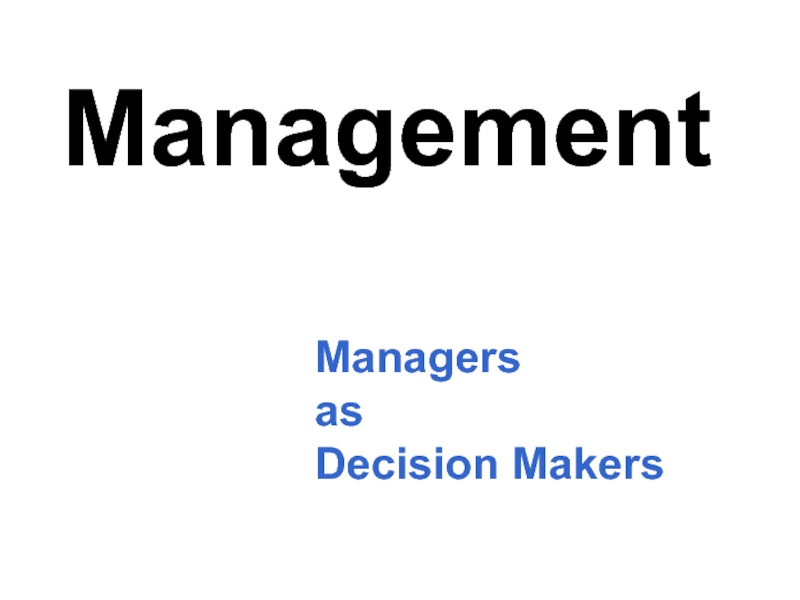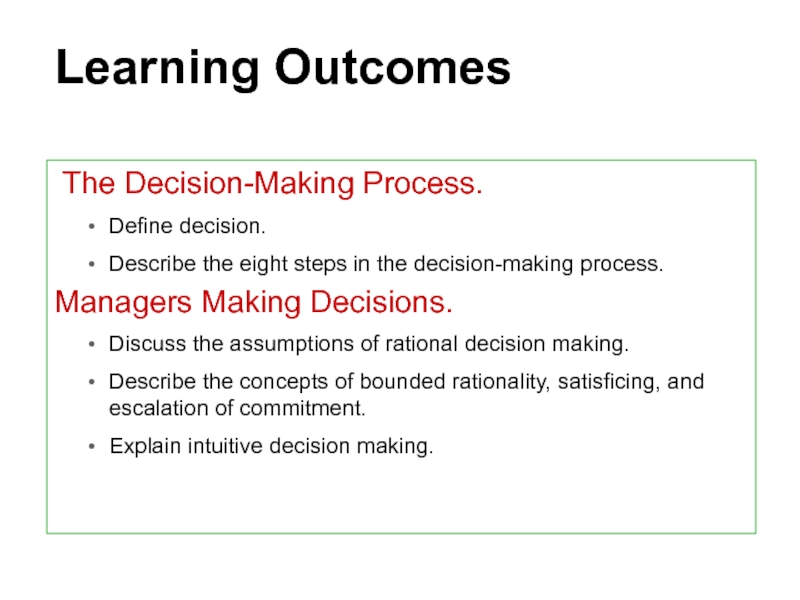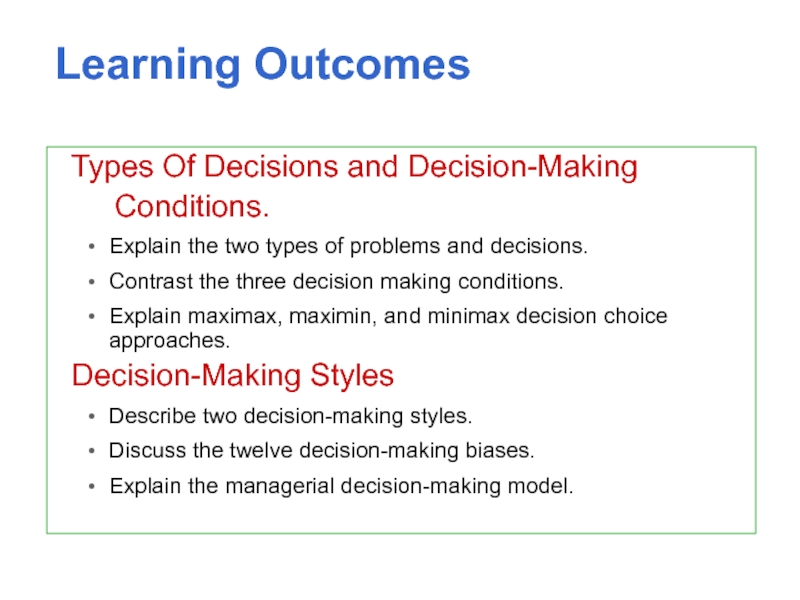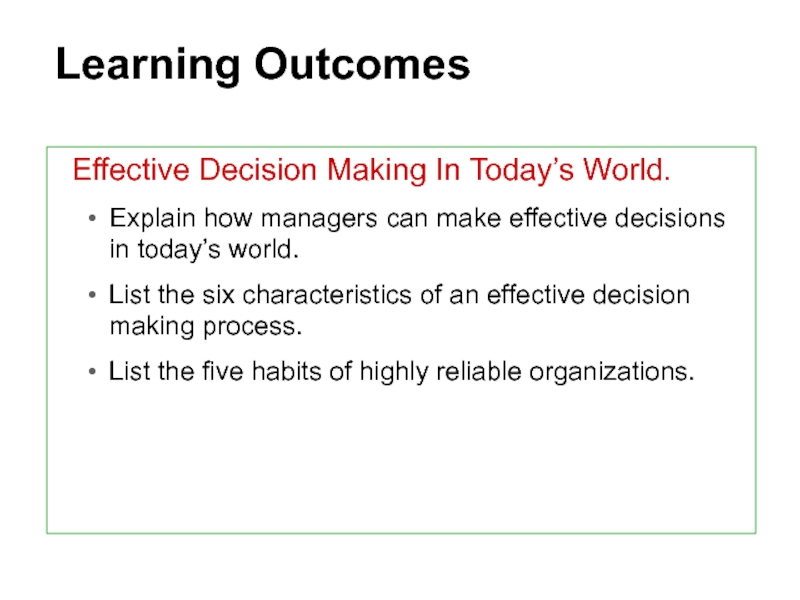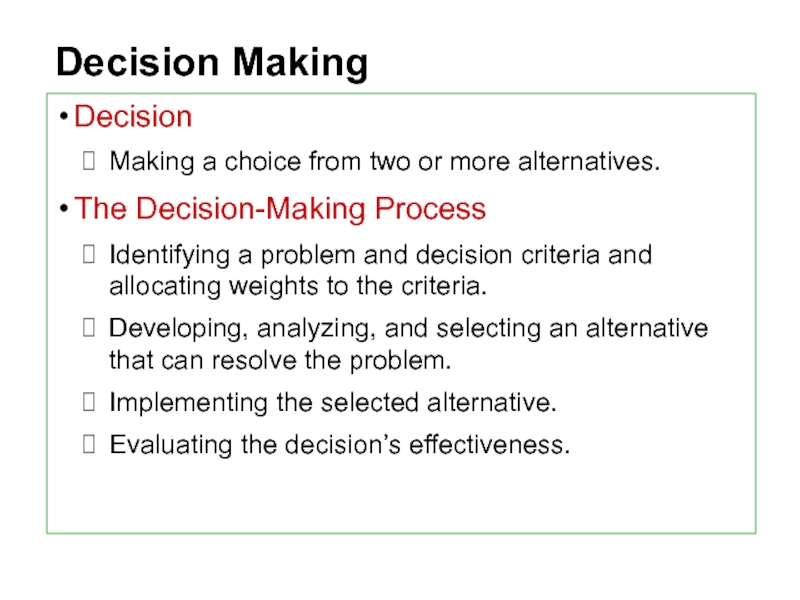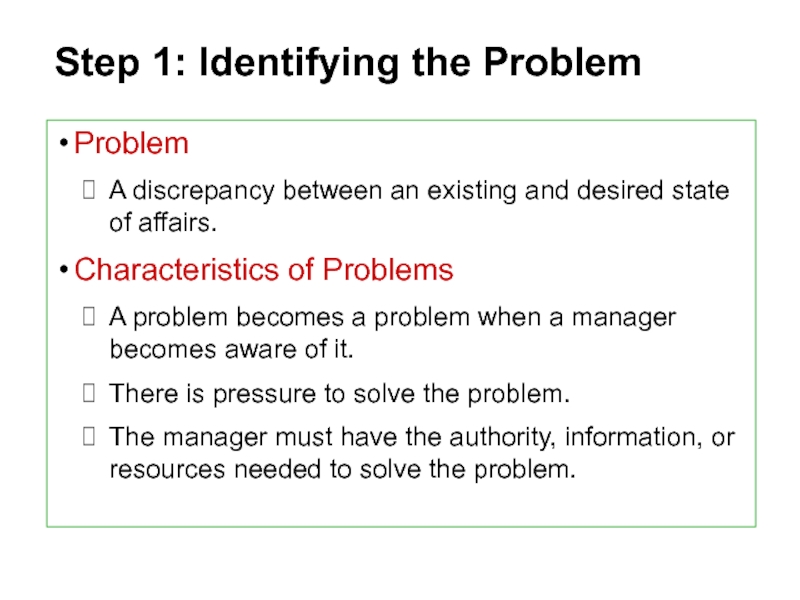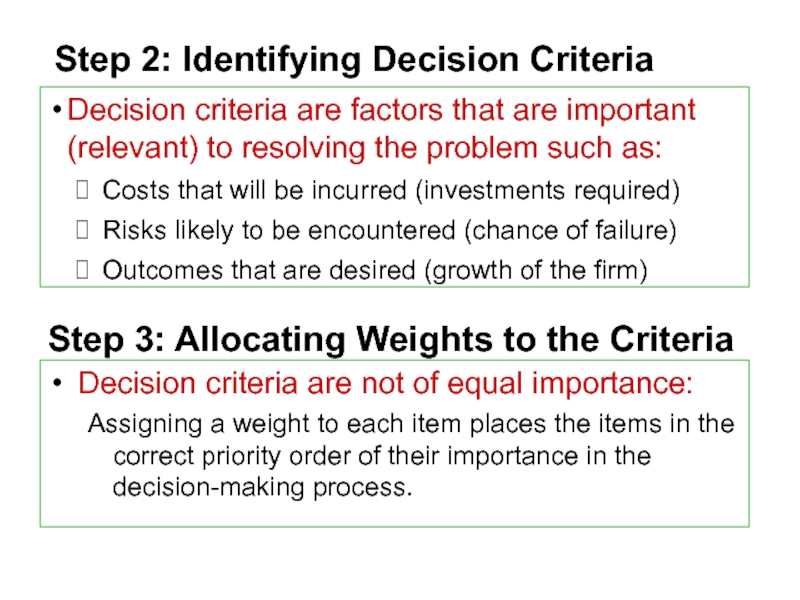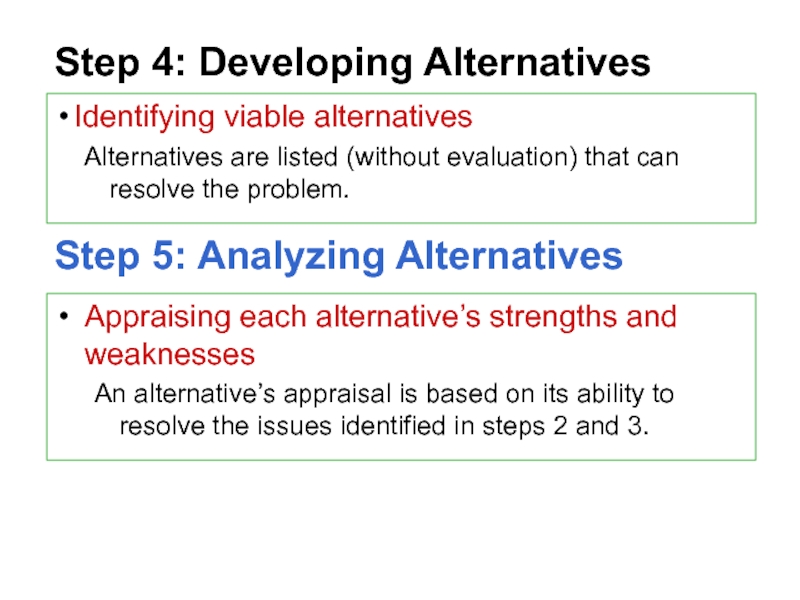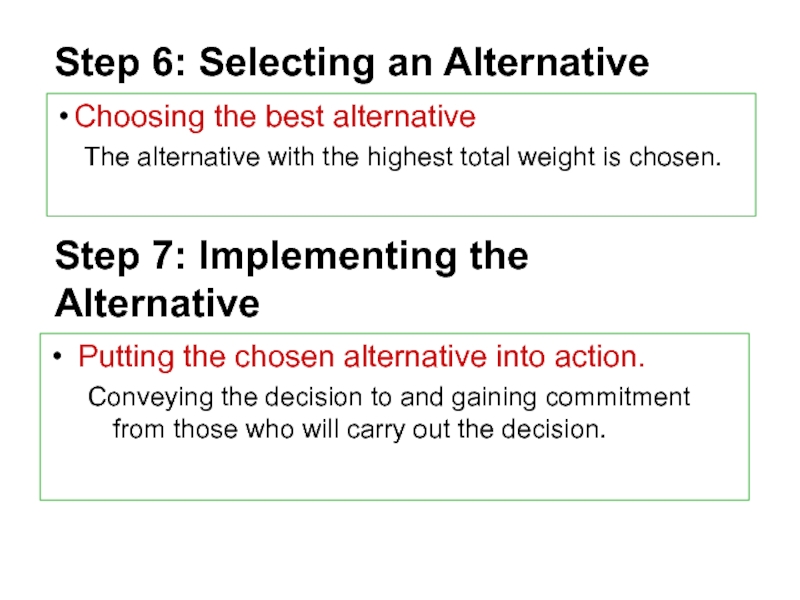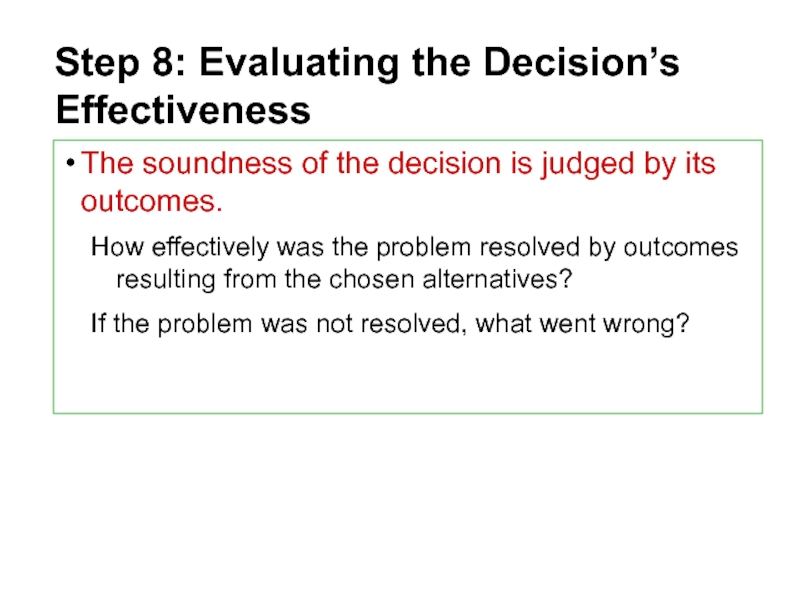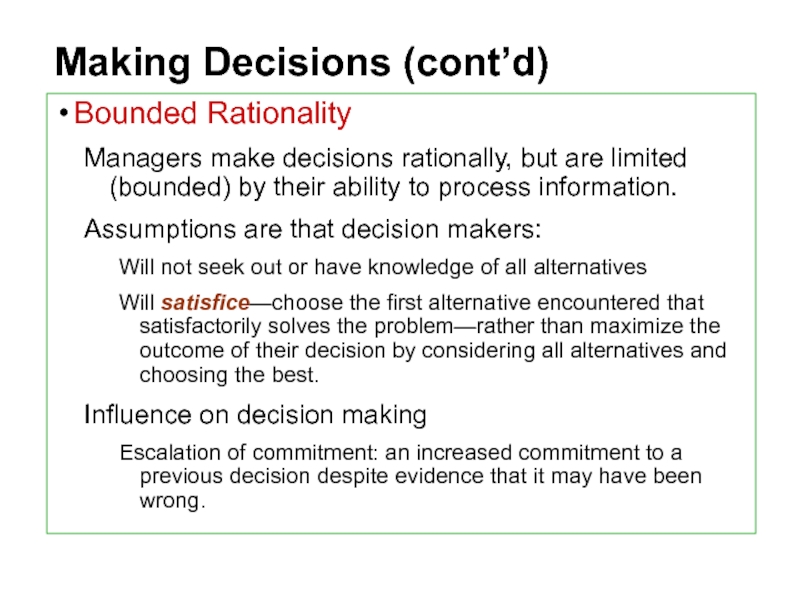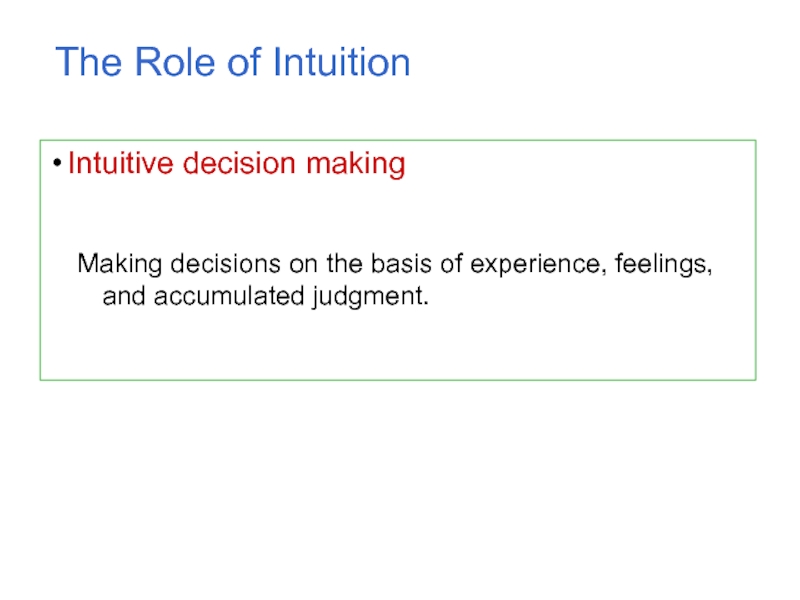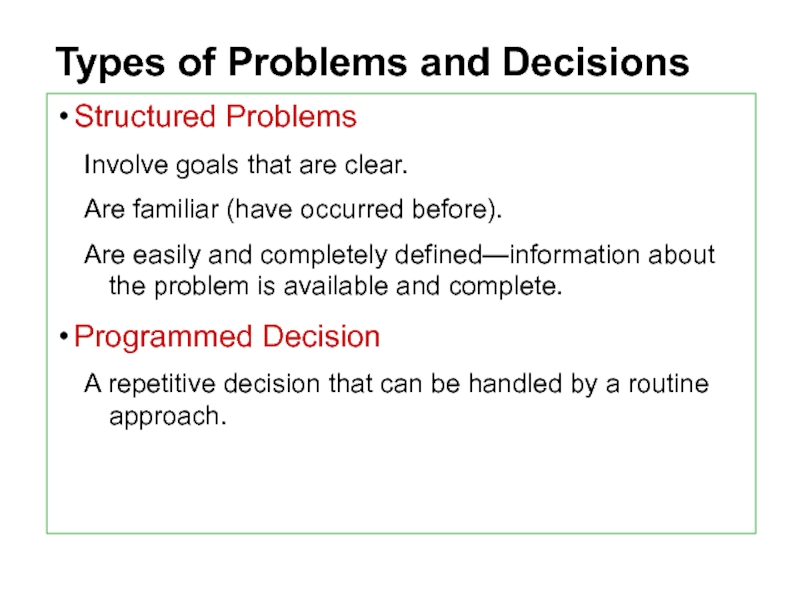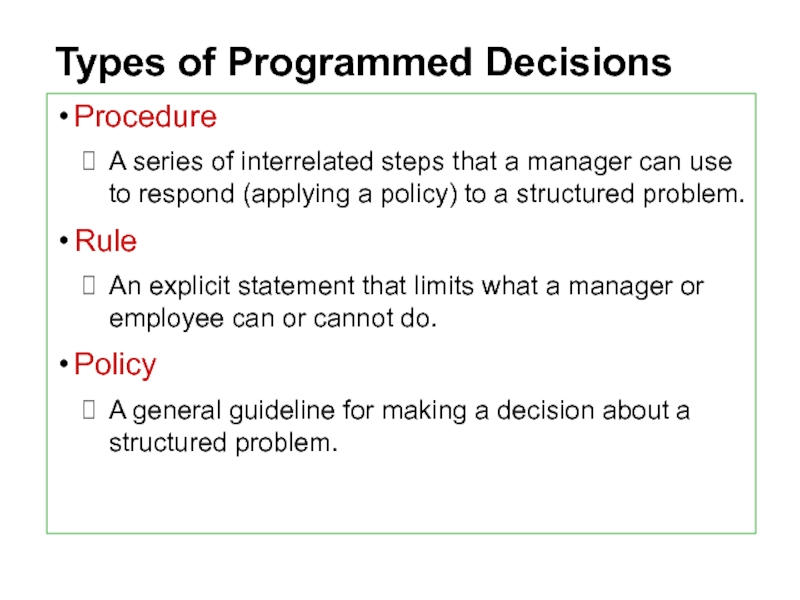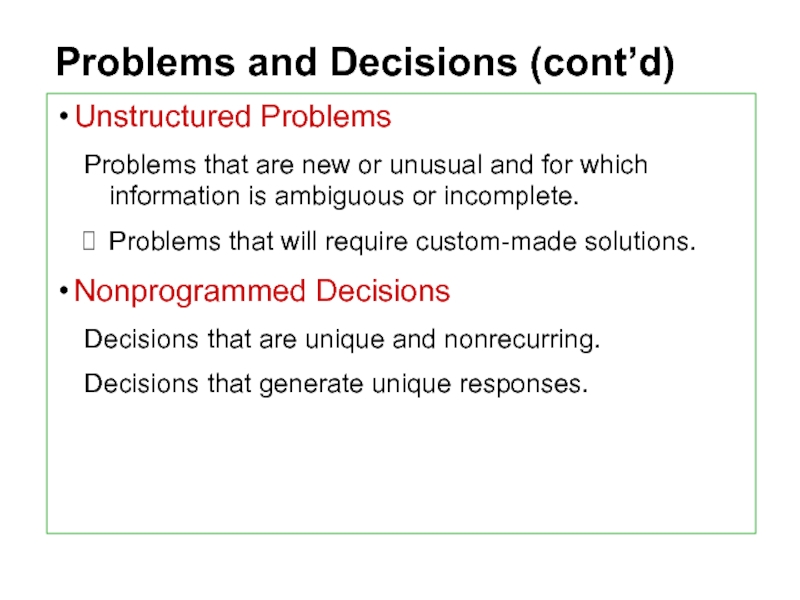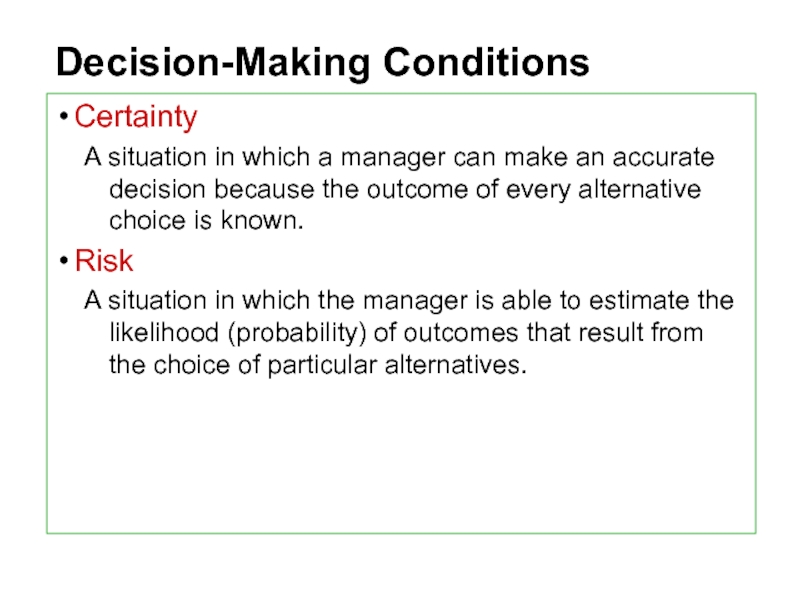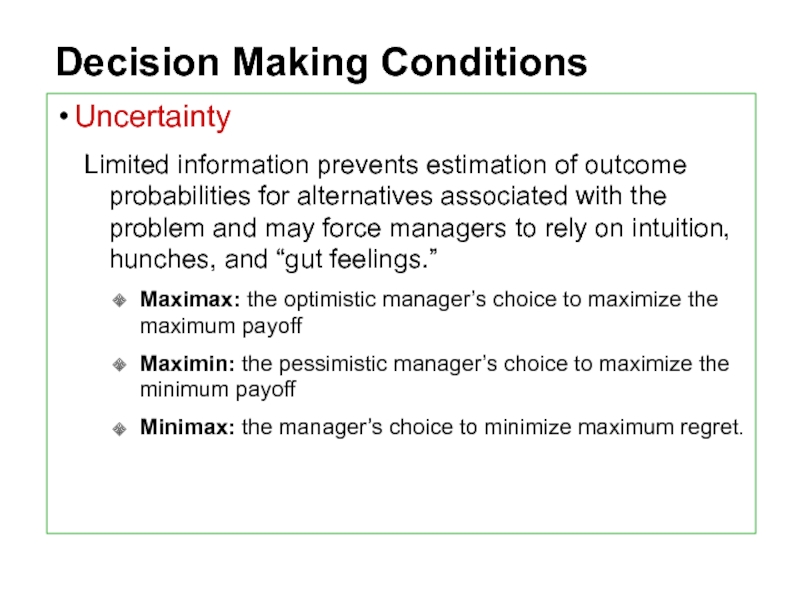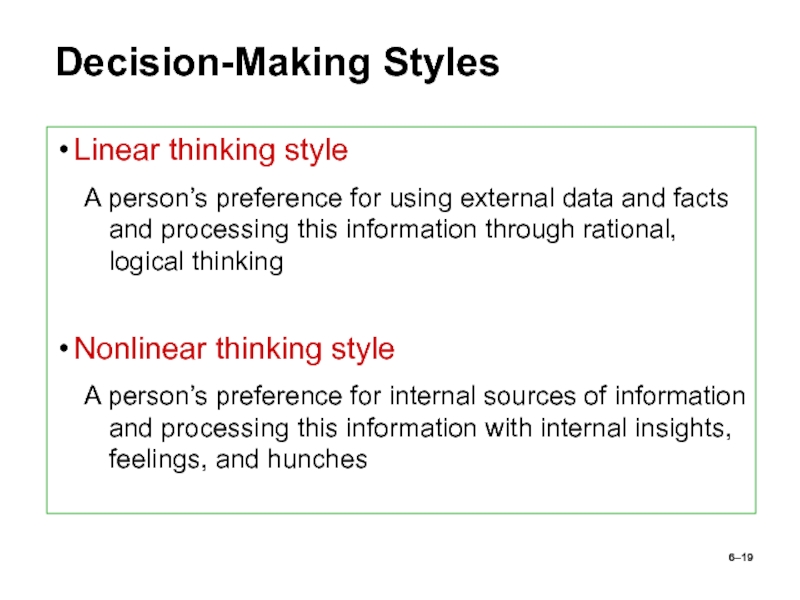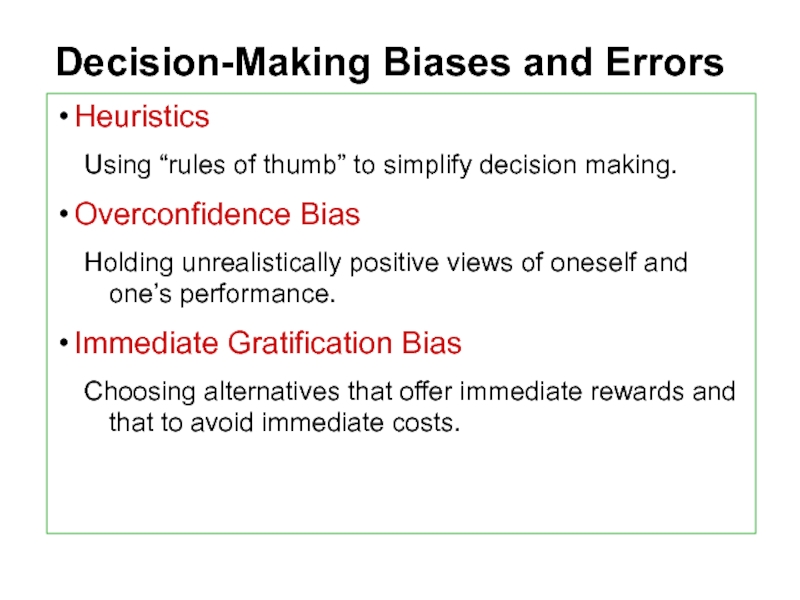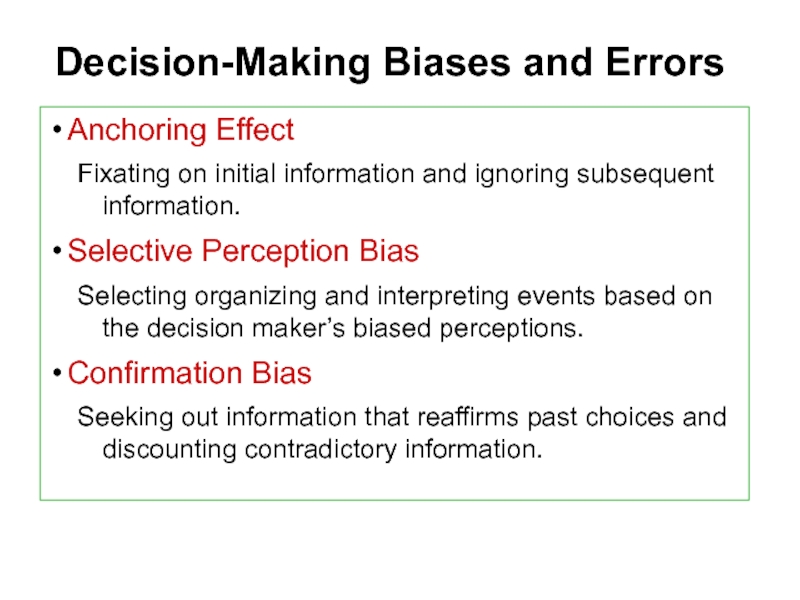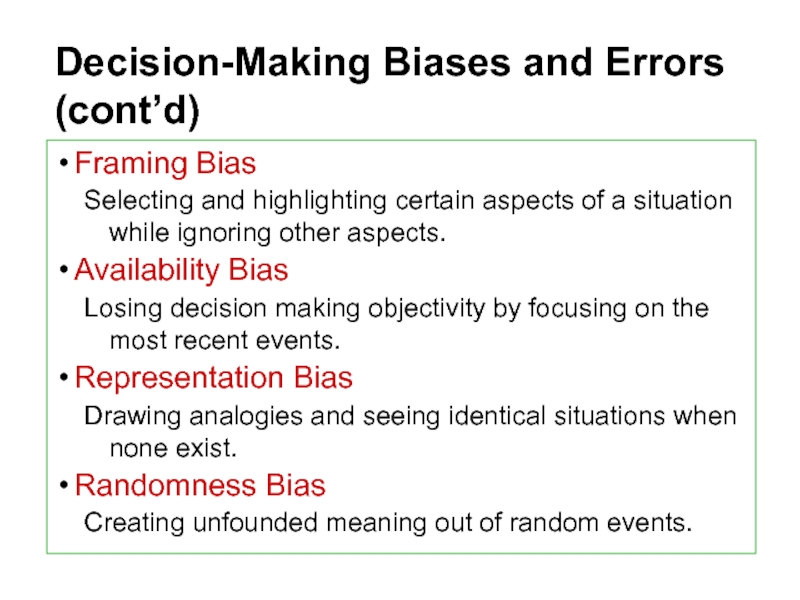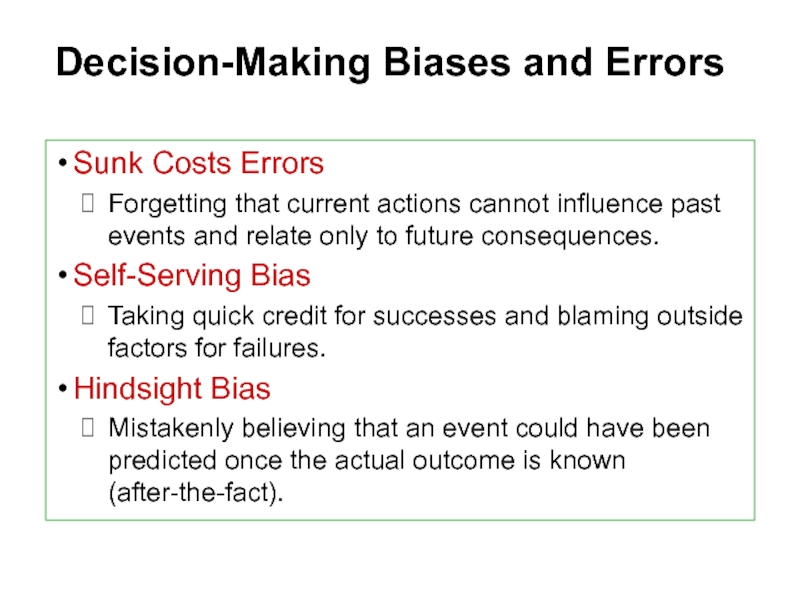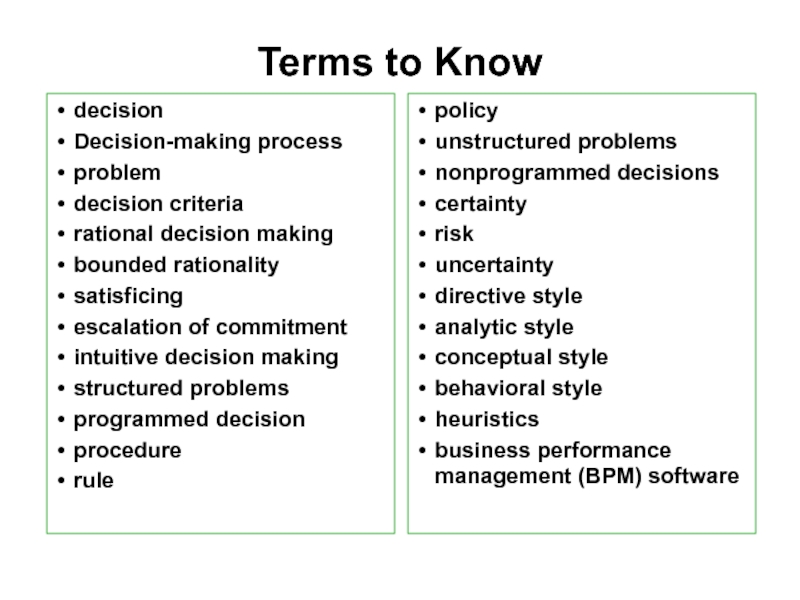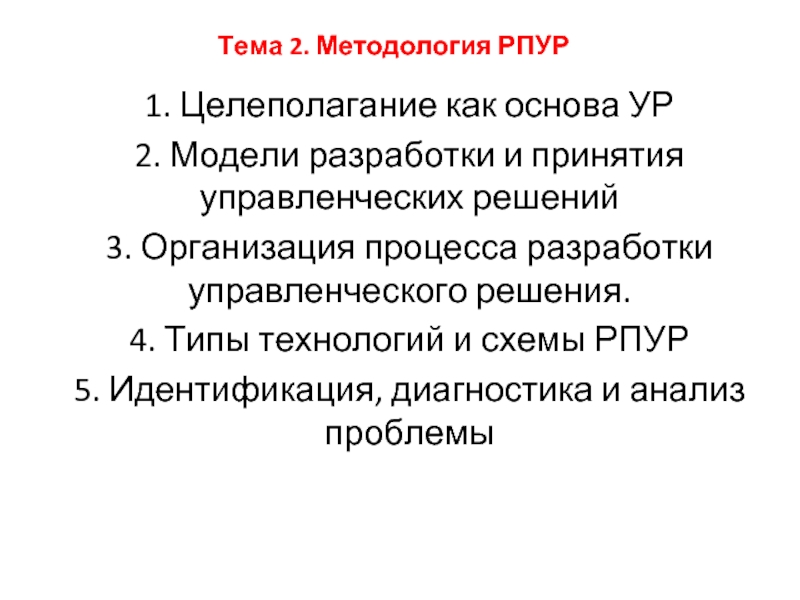- Главная
- Разное
- Дизайн
- Бизнес и предпринимательство
- Аналитика
- Образование
- Развлечения
- Красота и здоровье
- Финансы
- Государство
- Путешествия
- Спорт
- Недвижимость
- Армия
- Графика
- Культурология
- Еда и кулинария
- Лингвистика
- Английский язык
- Астрономия
- Алгебра
- Биология
- География
- Детские презентации
- Информатика
- История
- Литература
- Маркетинг
- Математика
- Медицина
- Менеджмент
- Музыка
- МХК
- Немецкий язык
- ОБЖ
- Обществознание
- Окружающий мир
- Педагогика
- Русский язык
- Технология
- Физика
- Философия
- Химия
- Шаблоны, картинки для презентаций
- Экология
- Экономика
- Юриспруденция
Managers as Decision Makers презентация
Содержание
- 1. Managers as Decision Makers
- 2. Learning Outcomes The Decision-Making Process.
- 3. Learning Outcomes Types Of Decisions and
- 4. Learning Outcomes Effective Decision Making In
- 5. Decision Making Decision Making a choice from
- 6. Step 1: Identifying the Problem Problem A
- 7. Step 2: Identifying Decision Criteria Decision criteria
- 8. Step 4: Developing Alternatives Identifying viable alternatives
- 9. Step 6: Selecting an Alternative Choosing the
- 10. Step 8: Evaluating the Decision’s Effectiveness The
- 11. Making Decisions (cont’d) Bounded Rationality Managers make
- 12. The Role of Intuition Intuitive decision making
- 13. Types of Problems and Decisions Structured Problems
- 14. Types of Programmed Decisions Procedure A series
- 15. Policy, Procedure, and Rule Examples Policy Accept
- 16. Problems and Decisions (cont’d) Unstructured Problems Problems
- 17. Decision-Making Conditions Certainty A situation in which
- 18. Decision Making Conditions Uncertainty Limited information prevents
- 19. 6– Decision-Making Styles Linear thinking style A
- 20. Decision-Making Biases and Errors Heuristics Using “rules
- 21. Decision-Making Biases and Errors Anchoring Effect
- 22. Decision-Making Biases and Errors (cont’d) Framing Bias
- 23. Decision-Making Biases and Errors Sunk Costs
- 24. Terms to Know decision Decision-making process problem
Слайд 2Learning Outcomes
The Decision-Making Process.
Define decision.
Describe the eight steps in the
Managers Making Decisions.
Discuss the assumptions of rational decision making.
Describe the concepts of bounded rationality, satisficing, and escalation of commitment.
Explain intuitive decision making.
Слайд 3Learning Outcomes
Types Of Decisions and Decision-Making
Explain the two types of problems and decisions.
Contrast the three decision making conditions.
Explain maximax, maximin, and minimax decision choice approaches.
Decision-Making Styles
Describe two decision-making styles.
Discuss the twelve decision-making biases.
Explain the managerial decision-making model.
Слайд 4Learning Outcomes
Effective Decision Making In Today’s World.
Explain how managers can
List the six characteristics of an effective decision making process.
List the five habits of highly reliable organizations.
Слайд 5Decision Making
Decision
Making a choice from two or more alternatives.
The Decision-Making Process
Identifying
Developing, analyzing, and selecting an alternative that can resolve the problem.
Implementing the selected alternative.
Evaluating the decision’s effectiveness.
Слайд 6Step 1: Identifying the Problem
Problem
A discrepancy between an existing and desired
Characteristics of Problems
A problem becomes a problem when a manager becomes aware of it.
There is pressure to solve the problem.
The manager must have the authority, information, or resources needed to solve the problem.
Слайд 7Step 2: Identifying Decision Criteria
Decision criteria are factors that are important
Costs that will be incurred (investments required)
Risks likely to be encountered (chance of failure)
Outcomes that are desired (growth of the firm)
Step 3: Allocating Weights to the Criteria
Decision criteria are not of equal importance:
Assigning a weight to each item places the items in the correct priority order of their importance in the decision-making process.
Слайд 8Step 4: Developing Alternatives
Identifying viable alternatives
Alternatives are listed (without evaluation) that
Step 5: Analyzing Alternatives
Appraising each alternative’s strengths and weaknesses
An alternative’s appraisal is based on its ability to resolve the issues identified in steps 2 and 3.
Слайд 9Step 6: Selecting an Alternative
Choosing the best alternative
The alternative with the
Step 7: Implementing the Alternative
Putting the chosen alternative into action.
Conveying the decision to and gaining commitment from those who will carry out the decision.
Слайд 10Step 8: Evaluating the Decision’s Effectiveness
The soundness of the decision is
How effectively was the problem resolved by outcomes resulting from the chosen alternatives?
If the problem was not resolved, what went wrong?
Слайд 11Making Decisions (cont’d)
Bounded Rationality
Managers make decisions rationally, but are limited (bounded)
Assumptions are that decision makers:
Will not seek out or have knowledge of all alternatives
Will satisfice—choose the first alternative encountered that satisfactorily solves the problem—rather than maximize the outcome of their decision by considering all alternatives and choosing the best.
Influence on decision making
Escalation of commitment: an increased commitment to a previous decision despite evidence that it may have been wrong.
Слайд 12The Role of Intuition
Intuitive decision making
Making decisions on the basis of
Слайд 13Types of Problems and Decisions
Structured Problems
Involve goals that are clear.
Are familiar
Are easily and completely defined—information about the problem is available and complete.
Programmed Decision
A repetitive decision that can be handled by a routine approach.
Слайд 14Types of Programmed Decisions
Procedure
A series of interrelated steps that a manager
Rule
An explicit statement that limits what a manager or employee can or cannot do.
Policy
A general guideline for making a decision about a structured problem.
Слайд 15Policy, Procedure, and Rule Examples
Policy
Accept all customer-returned merchandise.
Procedure
Follow all steps for
Rules
Managers must approve all refunds over $50.00.
No credit purchases are refunded for cash.
Слайд 16Problems and Decisions (cont’d)
Unstructured Problems
Problems that are new or unusual and
Problems that will require custom-made solutions.
Nonprogrammed Decisions
Decisions that are unique and nonrecurring.
Decisions that generate unique responses.
Слайд 17Decision-Making Conditions
Certainty
A situation in which a manager can make an accurate
Risk
A situation in which the manager is able to estimate the likelihood (probability) of outcomes that result from the choice of particular alternatives.
Слайд 18Decision Making Conditions
Uncertainty
Limited information prevents estimation of outcome probabilities for alternatives
Maximax: the optimistic manager’s choice to maximize the maximum payoff
Maximin: the pessimistic manager’s choice to maximize the minimum payoff
Minimax: the manager’s choice to minimize maximum regret.
Слайд 196–
Decision-Making Styles
Linear thinking style
A person’s preference for using external data and
Nonlinear thinking style
A person’s preference for internal sources of information and processing this information with internal insights, feelings, and hunches
Слайд 20Decision-Making Biases and Errors
Heuristics
Using “rules of thumb” to simplify decision making.
Overconfidence
Holding unrealistically positive views of oneself and one’s performance.
Immediate Gratification Bias
Choosing alternatives that offer immediate rewards and that to avoid immediate costs.
Слайд 21Decision-Making Biases and Errors
Anchoring Effect
Fixating on initial information and ignoring
Selective Perception Bias
Selecting organizing and interpreting events based on the decision maker’s biased perceptions.
Confirmation Bias
Seeking out information that reaffirms past choices and discounting contradictory information.
Слайд 22Decision-Making Biases and Errors (cont’d)
Framing Bias
Selecting and highlighting certain aspects of
Availability Bias
Losing decision making objectivity by focusing on the most recent events.
Representation Bias
Drawing analogies and seeing identical situations when none exist.
Randomness Bias
Creating unfounded meaning out of random events.
Слайд 23Decision-Making Biases and Errors
Sunk Costs Errors
Forgetting that current actions cannot
Self-Serving Bias
Taking quick credit for successes and blaming outside factors for failures.
Hindsight Bias
Mistakenly believing that an event could have been predicted once the actual outcome is known (after-the-fact).
Слайд 24Terms to Know
decision
Decision-making process
problem
decision criteria
rational decision making
bounded rationality
satisficing
escalation of commitment
intuitive decision
structured problems
programmed decision
procedure
rule
policy
unstructured problems
nonprogrammed decisions
certainty
risk
uncertainty
directive style
analytic style
conceptual style
behavioral style
heuristics
business performance management (BPM) software
